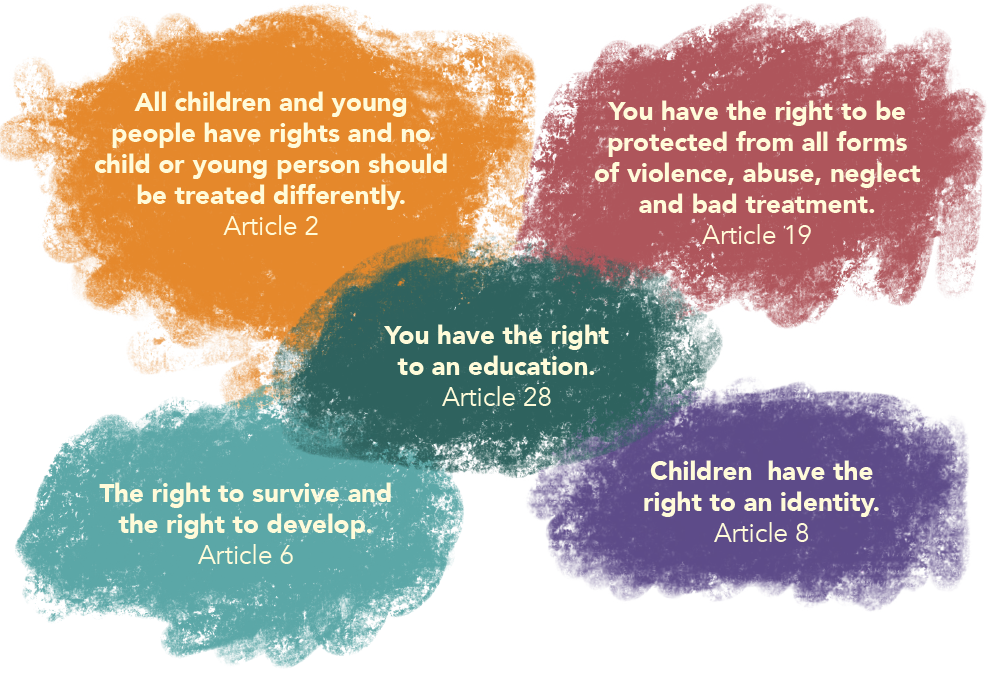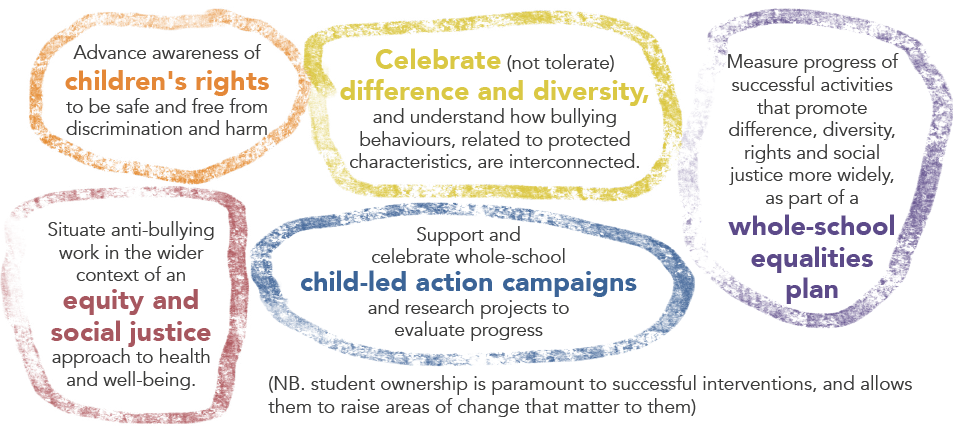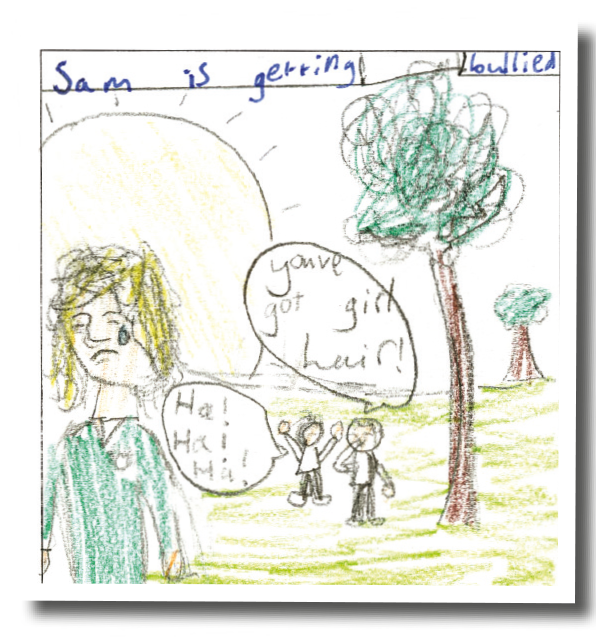Addressing bullying cultures in schools through art, stories, drama, helping hands and a cwtch.
‘Sam’s Story’ is the culmination of a large-scale consultation by the Children’s Commissioner for Wales, with over 2,000 children and young people and nearly 300 professionals’ views about contemporary experiences of bullying in Wales. An analysis of the material from children and young people and professionals produced key findings in a report with recommendations for the Welsh Government, schools and local authorities published in July 2017.
‘Sam’s Story: Listening to children and young people’s experiences of bullying in Wales.’
This case study shares some of the process and provides practitioners with ideas of how to use ‘Sam’s Story’ to explore gender-based and sexual bullying in the wider context of children’s rights and equity.
When a child is bullied their rights, under the UN Convention on the Rights of the Child (UNCRC), are being violated. Key to preventing bullying is instilling a rights-based approach in schools. See the Children’s Commissioner for Wales’ report ‘A Right Way, a children’s rights approach for education in Wales’ for further information.
Gathering experiences through stories
To explore children’s perceptions of bullying, ‘Sam’s Story’ engaged children and young people in projective exercises which allowed them to express their feelings and experiences through an imaginary character called ‘Sam’. The Commissioner’s team asked children to tell ‘Sam’s Story’, specifying that Sam was their age, from their community and was experiencing bullying. Sam’s gender was not specified. For primary-aged children a range of simple templates were provided to support them to create a picture, cartoon or written narrative. Alongside the templates, the Commissioner’s team provided scaffolding questions which could be used to help children structure their responses to include possible solutions for change as well as Sam’s experiences.
‘Sam’s Story’ enabled the Commissioner’s team to understand what identity-based bullying looks and feels like. Identity-based bullying refers to any form of bullying related to the characteristics considered part of a person’s identity or perceived identity group (Equality and Human Rights Commission, 2010). This can include their disability, gender, gender identity, race, religion or belief or sexual orientation. These are referred to as protected characteristics by the Equality Act 2010.

An insight into Sam’s experience: stories and drama workshops
Through the many visual images and written stories that were received about ‘Sam’, ‘Sam’ became the voice of the bullied, the bully and the bystander, and a complex social world of bullying cultures emerged. ‘Sam’ was often portrayed as being different to other children in some way and this was implicitly or explicitly linked to being the target of bullying cultures. Social pressures to conform to a range of norms included issues such as physical appearance, disability, poverty, ethnicity, religion, sexuality and not conforming to gender stereotypes. Some children talked about how difficult it was to break free of social norms, even if they wanted to.
![]()
As well as gathering written and visual material, the Commissioner’s team engaged groups in freeze frame drama workshops. This enabled participants to place themselves within scenarios that might reflect Sam’s experiences. Groups discussed the impacts of bullying and possible solutions for change. To try this out go to the DIY activity, Freeze Framing Bullying. All the written and visual material as well as notes recorded form the freeze frame workshops were analysed and presented as findings along with recommendations for Welsh Government, Schools, and Local Authorities in the report ‘Sam’s Story: Listening to children and young people’s experiences of bullying in Wales.’
Example: Story written by a primary school pupil
Once upon a time, there was a little girl called Sam and she was new to her school. She was friends with all the popular girls, until suddenly, she saw a football outside.
She said, “Do you want to play footy?” to the popular girls
“Ewww, no. That’s a boys game, you weirdo” the popular girls said “Why do you even like that?”
Sam began to feel sad and worried.
She wanted to tell someone but she was worried it would make it worse. She kept feeling mixed emotions because they kept following her around and calling her mean names.
So then she classed it as bullying because they were doing it constantly. She wanted to tell someone, but she was afraid that if she did, it would change from verbal bullying to physical bullying.
Sam sat down at lunch, on her own, then another girl who was sat on her own came over.
She said “Hello, do you want to be friends?”
Sam said “Yes, but I’ll warn you…I’m a bit of a tomboy”
“That’s OK, me too”
A number of children’s rights in the UNCRC are threatened or denied in the many descriptions of bullying that we received as part of ‘Sam’s Story’.
Particularly relevant are:

"Everyone needs educating on why people are different, awareness raising e.g. my friend has spasms and makes involuntary noises and people think she is stupid because she can’t talk so they laugh at her – she understands all this and is very intelligent" (community ambassador group)

“All students should do anti-bullying weeks where they think through the consequences of bullying and how it makes people feel and talk through solutions and how important it is to talk – we did this at my school and it helped” (community ambassador group)
Locating ‘Sam’s Story’ in a whole school approach to healthy relationships education
After listening to young people’s experiences of bullying, one of the Commissioner’s key recommendations from this work was that children and young people of all ages have time to reflect on and discuss their relationships. Children benefit from opportunities like circle time and other fora in which they can reflect and discuss peer relationships and behaviour.
‘Sam’s Story’ activities created space for further discussion and reflection on the experiences that children shared through taking part in the activities. In November 2017, the Commissioner published resources for both Primary and Secondary Schools, these resources provide practical ideas and activities for teachers and pastoral support officers linked to the curriculum.

Penygawsi Primary School took a whole school approach to delivering the original ‘Sam’s Story’ special mission, developing a series of differentiated lesson plans for each key stage and adapting existing resources. The Commissioner’s team worked with a teacher at the school to co-produce an anti-bullying resource which showcased the whole school teaching approach Penygawsi took. Read it here.

In our shoes: Taking Sam’s Story messages to the National Assembly for Wales
In November 2017, the Commissioner exhibited a selection of images and words, created and authored by children and young people, gathered as part of the ‘Sam’s Story’ consultation. This was an opportunity to highlight the real impact that being bullied is having on children’s lives in Wales, bringing these messages directly to public visitors to the National Assembly for Wales and decision makers based there.
A group of young artists as part of the group, Criw Celf, contributed an artistic response to the material we originally gathered, exploring the idea of putting themselves in ‘Sam’s shoes’. The group of young artist were provided with a selection of the visual images, written stories and blogs we received for the group to reflect on and discuss. The group used an old pair of shoes as a starting point for their individual responses, adapting and adding new materials and objects to create their own contemporary three dimensional art.

The Public Sector Equality Duty (PSED)
The Public Sector Equality Duty requires schools to take action to improve outcomes for pupils with different protected characteristics. It is a legal requirement, under the Equality Act 2010. The PSED can be used as a helpful mechanism to tackle identity-based bullying and implement a preventative whole school approach that teaches children good relationships and conflict resolution skills from an early age and ensure clear strategies for recognising and tackling identity-based bullying when it occurs.
Addressing Bullying Cultures in School
What is bullying?
Bullying is the abuse of social and cultural power relations that are persistently directed towards targeted people or groups of people over time. It can be covert or overt and expressed in verbal, physical, psychological, material, or technological ways.
What can schools do?
Bullying behaviours frequently reinforce what is socially and culturally acceptable (e.g. what a 'boy' can wear or where a child should live). Individual or groups of children and young people who are perceived as 'different' from the 'norm' are frequent targets of bullying.
If bullying behaviours are understood as the micro-expression of wider persistent social inequalities, best practice for schools is to work towards interventions that address bullying cultures in the context of rights, equity and social justice.
Best practice includes developing whole-school policies and practices with children, parents/carers and the wider community to develop proactive and affirmative interventions that:











